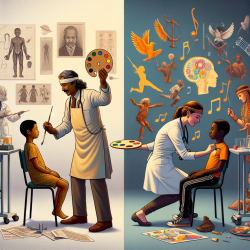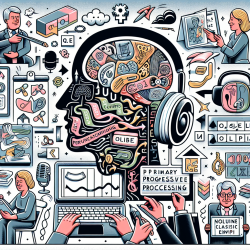Revolutionize Child Therapy: The Secret Power of Arts-Based Interventions in LMICs!

In the realm of child development, especially in low- and middle-income countries (LMICs), the integration of arts-based interventions has shown significant promise. The recent realist review, "Coproduced, arts interventions for nurturing care (0–5 years) in low-income and middle-income countries (LMICs): a realist review," offers valuable insights into how these interventions can be effectively implemented. Here’s how practitioners can leverage these findings to enhance their skills and improve outcomes for children.
Key Findings from the Review
The review identified three main pathways for the success of arts-based interventions:
- Participatory Design: Valuing different sources of expertise and involving local communities in the design process.
- Contextual Adaptation: Tailoring interventions to fit the local cultural and social context.
- Community Participation: Engaging communities through arts-based activities.
Implementing Arts-Based Interventions: A Practitioner’s Guide
To effectively implement arts-based interventions in LMICs, practitioners should consider the following steps:
1. Embrace Participatory Design
Involving local communities in the design of interventions ensures that the solutions are culturally relevant and more likely to be accepted. This can be achieved by:
- Conducting focus groups and community meetings to gather input and feedback.
- Collaborating with local artists and cultural leaders to co-create intervention materials.
2. Tailor Interventions to Local Context
Understanding the local cultural, social, and economic context is crucial for the success of any intervention. Practitioners should:
- Conduct formative research to identify local norms and behaviors.
- Adapt existing interventions to fit the local context, using local languages and culturally relevant themes.
3. Foster Community Participation
Community involvement is key to the sustainability and effectiveness of interventions. Practitioners can:
- Engage local artists and community groups to deliver the intervention.
- Use a variety of arts-based activities such as storytelling, drama, and music to engage different segments of the community.
Encouraging Further Research
While the review provides a solid foundation, there is still much to learn about the effectiveness of arts-based interventions. Practitioners are encouraged to:
- Document and share their experiences and outcomes to contribute to the growing body of evidence.
- Collaborate with researchers to conduct rigorous evaluations of their interventions.
Conclusion
The integration of arts-based interventions in child therapy, especially in LMICs, holds great potential. By embracing participatory design, tailoring interventions to the local context, and fostering community participation, practitioners can create impactful and sustainable solutions. To read the original research paper, please follow this link:
Coproduced, arts interventions for nurturing care (0–5 years) in low-income and middle-income countries (LMICs): a realist review.
Citation: Gale, N. K., Ahmed, K., Diarra, N. H., Manaseki-Holland, S., Asamane, E., Sidibé, C. S., Touré, O., Wilson, M., & Griffiths, P. (2024). Coproduced, arts interventions for nurturing care (0–5 years) in low-income and middle-income countries (LMICs): a realist review. BMJ Open. https://doi.org/10.1136/bmjopen-2023-083093










